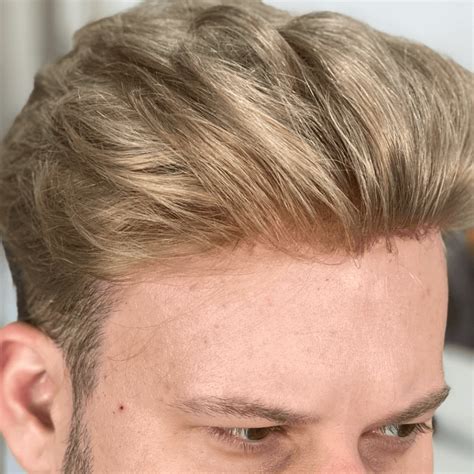Hair loss is a common issue affecting millions of men worldwide. It can significantly impact their confidence and self-esteem. Fortunately, modern hair systems offer a discreet and effective solution to restore a full head of hair. This comprehensive guide explores 10 essential strategies for choosing, maintaining, and styling men’s hair systems for a natural and long-lasting look.

1. Determine Your Hair Loss Pattern
Understanding your hair loss pattern is crucial for selecting the most suitable hair system. Common patterns include male pattern baldness, receding hairline, and thinning hair on the crown or sides. Consult a professional hair expert to diagnose your specific pattern and recommend appropriate system designs.
2. Consider Base Material and Construction
The base material of a hair system directly affects its natural appearance, durability, and maintenance. Popular base materials include lace, poly, and mono. Each type offers unique advantages and disadvantages based on factors such as breathability, flexibility, and sheerness. Choose a base that aligns with your desired look and lifestyle.
3. Match Hair Type and Density
The choice of hair used in a system impacts its realism and naturalness. Human hair offers the most authentic texture and appearance, but it requires more meticulous care. Synthetic hair is more affordable and low-maintenance, but may not possess the same level of luster and movement. Determine the desired hair density and color to create a system that blends seamlessly with your existing hair.
4. Regular Cleaning and Conditioning
Hair systems require regular cleaning and conditioning to prevent buildup of oils, dirt, and product residue. Use specially formulated shampoos and conditioners designed for hair systems to avoid damaging the base or hair fibers. Follow manufacturer’s instructions for optimal hair system longevity.
5. Avoid Harsh Chemicals and Heat Styling
Chemical treatments, such as dyeing or perming, can weaken the hair fibers and damage the base of a hair system. If color changes are desired, consult a professional hair stylist experienced in hair system maintenance. Limit heat styling to prevent damage and keep the system looking its best.
6. Protect from Sun and Chlorine
Exposure to sunlight and chlorine can fade or discolor the hair system. Wear a hat or cap to protect it from the sun, and rinse the system thoroughly with clean water after swimming to remove chlorine.
7. Blend with Natural Hair
For a seamless transition, ensure that the hair system matches your existing hair in terms of texture, color, and length. Have it trimmed and styled by a professional barber or stylist who is familiar with hair system maintenance.
8. Use Hair Spray or Styling Products
Use hair spray or styling products specifically designed for hair systems to hold your style in place without weighing down the hair. Avoid using excessive amounts that may cause the hair to look unnatural or greasy.
9. Avoid Gluing Daily
Bonding adhesives are essential for securing a hair system, but excessive use can lead to damage. Follow the manufacturer’s recommendations for proper application and removal, and avoid gluing your hair system daily.
10. Enhanced Confidence and Self-Esteem
A natural-looking, properly maintained hair system can significantly boost a man’s confidence and self-esteem. It allows them to feel comfortable and self-assured in social and professional settings without worrying about hair loss.
Men’s hair systems offer a transformative solution to hair loss, empowering men to achieve a full head of hair for a natural and confident appearance. By following these essential strategies, you can choose, maintain, and style your hair system for optimal results. Remember, proper care, regular maintenance, and a positive attitude are key to a long-lasting, natural-looking hair system that will enhance your self-confidence and overall well-being.
Hair Loss Statistics
According to the American Hair Loss Association, approximately 85% of men will experience some form of hair loss by the age of 50. Male pattern baldness affects over 50% of men.
Market Size and Trends
The global hair system market is expected to reach $1.8 billion by 2027, driven by increasing acceptance of hair restoration solutions and advancements in hair system technology.
Innovative Applications
Recent advancements in hair system technology have led to the development of specialized systems for men with unique hair loss patterns, such as hairline receding and crown thinning.
Useful Tables
Table 1: Hair System Base Materials
| Base Material | Advantages | Disadvantages |
|---|---|---|
| Lace | Breathable, sheer, comfortable | Less durable, may require more maintenance |
| Poly | Durable, sweat-resistant, affordable | Less natural appearance, may be uncomfortable for long periods |
| Mono | Compromise between lace and poly, balanced breathability and durability | Limited flexibility |
Table 2: Hair System Construction
| Construction | Description | Advantages | Disadvantages |
|---|---|---|---|
| Toupee | Partial hair system, covers only the top of the head | Affordable, easy to maintain | Less seamless transition |
| Wig | Complete hair system that covers the entire head | Conceals entire hair loss pattern | May be more noticeable |
| Hair Integration | Combines existing hair with added hair fibers | Natural appearance, less maintenance | Requires skilled technique |
Table 3: Hair System Hair Types
| Hair Type | Source | Advantages | Disadvantages |
|---|---|---|---|
| Human Hair | Donated from humans | Natural appearance, realistic texture | More expensive, requires more care |
| Synthetic Hair | Made from artificial materials | Affordable, low-maintenance | Less realistic appearance, may not blend well |
| Hybrid Hair | Combination of human and synthetic hair | Balanced natural appearance and affordability | Requires blending to match existing hair |
Table 4: Hair System Maintenance
| Task | Frequency | Benefits |
|---|---|---|
| Cleaning | Weekly | Removes buildup, prevents damage |
| Conditioning | Every 2-3 weeks | Nourishes hair fibers, enhances shine |
| Bond Removal | As needed | Allows for cleaning, restyling |
| Bond Re-application | Varies depending on lifestyle and activity level | Secures hair system, ensures stability |
